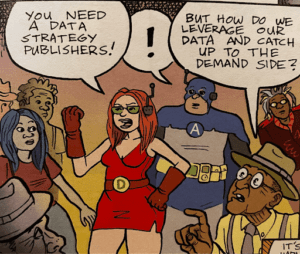 Podcast platform Art19 has taken a step to address the targeting and measurement problem standing between advertisers and a ripe audience of podcast listeners.
Podcast platform Art19 has taken a step to address the targeting and measurement problem standing between advertisers and a ripe audience of podcast listeners.
The company’s platform hosts and distributes podcasts while letting advertisers better target and monetize their audiences through an API integration and an ad server. It launched with hundreds of shows from partners Midroll Media, DGital Media and Wondery.
Art19’s WarpFeed ad server uses IP addresses and unspecified device data to insert targeted ads into offline podcast feeds upon download request. Publishers can also share their tokenized user data with Art19 for targeting and reporting purposes.
“Data has been a real source of pain for the podcasting industry,” said Sean Carr, founder and CEO at Art19. “We don’t know whether they’ve listened to content – just that they’ve downloaded.”
An assortment of tailored, host-read ad units are inserted into each podcast episode before being shipped to the listener for download. It’s not real-time in that ad decisioning doesn’t happen immediately before the ad is heard, but it’s the next best thing given Art19’s publisher partners produce download-only podcasts.
“The host can record three different versions for Canada, New York City or the week of July 4,” Carr said. “They can all be cut in dynamically, but they feel very native to the content itself.”
The API collects data about when a listener started, stopped and skipped an ad within an offline podcast stream. Carr calls this “listening telemetry,” or data about specific listening behaviors beyond the download metric.
That’s exciting for non-direct-response advertisers and their agencies who want to tap into podcast advertising. The platform was designed with agency input.
Twenty-one percent of people in the US listen to podcasts at least once per month and 13% listen at least once each week, according to Edison Research and Triton Digital’s The Infinite Dial, released in March. Those who listen to podcasts on a weekly basis consume an average of five podcasts per week. Podcast CPMs are generally high, and their native, host-read ads are often considered more engaging and less interruptive than those in any other medium.
“[Direct-response] buyers are coming back year after year, so we know this stuff works,” Carr said. “The problem is that the major agencies are limited by the lack of data.”
Another major hurdle to podcast advertising is that a majority of episodes are downloaded from Apple’s iTunes app, and the company will only share limited amounts of data.
“The big 800-pound gorillas out there are unlikely to deliver user data in the future,” Carr said.
When a podcast produced by an Art19 publisher partner is downloaded via iTunes, Apple redirects that request to Art19. Art19 picks up IP addresses and device data from Apple’s RSS feed through the redirect.
But even that can be used to determine location, device and carrier, Carr said.
Despite the launch of a programmatic podcast exchange, Carr said programmatic podcast advertising is still a distant dream.
“I think programmatic will have a place in the future of podcasting, but it’s quite a ways off,” he said. “But the effectiveness of podcast advertising comes from the host weaving the ad content into the fabric of the show. That’s what’s commanding these great CPMs. Programmatic doesn’t offer that.”
Updated with accurate information about Art19’s API.












